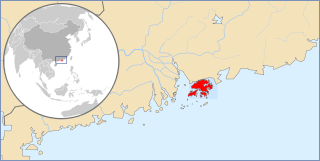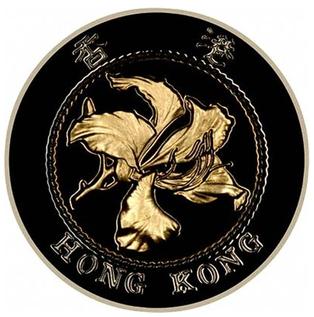The mill or mil is a unit of currency, used in several countries as one-thousandth of the base unit. It is symbolized as ₥, the MILL SIGN character in Unicode.

The pound, or lira, was the currency of Cyprus, including the Sovereign Base Areas in Akrotiri and Dhekelia, from 1879 to 2007, when the Republic of Cyprus adopted the euro. However, the self-proclaimed Turkish Republic of Northern Cyprus uses the Turkish lira as its official currency.
The Hong Kong coinage, including 10¢, 20¢, 50¢, $1, $2, $5 & $10, is issued by Hong Kong Monetary Authority on behalf of the Government of Hong Kong. From 1863 until 1992, these coins were embossed with the reigning British monarch's effigy. Since 1 January 1993, a new series depicting the bauhinia flower was gradually issued, including a new denomination of $10. Since the beginning of the coin replacement programme on 1 January 1993, over 585 million coins featuring Queen Elizabeth II have been withdrawn from circulation. However, these coins remain legal tender. The total value of coins in circulation in Hong Kong can be found in Monthly Statistical Bulletin and the Annual Report.

The issue of banknotes of the Hong Kong dollar is governed in the Special Administrative Region of Hong Kong by the Hong Kong Monetary Authority (HKMA), the governmental currency board and central bank of Hong Kong. Under licence from the HKMA, three commercial banks issue their own banknotes for general circulation in the region. Notes are also issued by the HKMA itself.

The cash was a currency denomination used in China in imperial times. It was the chief denomination until the introduction of the yuan in the late 19th century.

The one-dollar coin is a denomination of the Hong Kong dollar.

The one-cent banknote was the smallest denominated banknote issued in Hong Kong. They were issued by the government and were initially released on 30 May 1941 and printed by Noronha and Company Limited to provide small change because of a lack of coinage brought on by the Second World War. The first issue was 42 by 75 mm, the obverse was brown with a serial number of seven numbers with either no prefix or an A or B prefix. This side was mostly in English, except for "Government of Hong Kong" which was also in Chinese. The reverse was red and the denomination in English and Chinese. After the Japanese take over of Hong Kong the issue was replaced by the Japanese Military Yen.
The ten-cent coin is the lowest-denomination circulating coin of the Hong Kong dollar. With a diameter of 17.5 millimetres (0.69 in) and a mass of 1.85 grams (0.065 oz) it is also the smallest in size and weight. It is the oldest coin denomination to still be in circulation in Hong Kong. Since its first issue in 1863, there has only been one period (1942–1947) where the coin was not in use.

The ten-dollar coin is the highest-valued circulating coin issued in Hong Kong.
The five-dollar coin is the second-highest-denomination coin of the Hong Kong dollar. It replaced the five-dollar banknote in 1976.

The two dollar coin is the third-highest denomination coin of the Hong Kong dollar. Since its introduction in 1976, it is one of two circulating coins to not be round. The two dollar coin is a dodecagonal scallop in shape, and made of cupro-nickel.
The ten-dollar note was first produced in 1868 by The Hongkong and Shanghai Banking Corporation with the formal adoption of a currency system just for Hong Kong. There had been a variety of the green coloured ten-dollar notes issued by several banks concurrently. These were all phased out with the introduction of the ten dollar coin in 1994.

The twenty-cent coin is a coin of the Hong Kong dollar. It is the second-smallest denomination coin in Hong Kong. There have been two different periods of usage for a twenty-cent coin: the first, round twenty-cent was issued from 1866 to 1905, and the current scallop-shaped coin was introduced in 1975.
The fifty-cent coin was first introduced as a .900 purity silver half dollar in 1866. These coins were 13.41 grams, with a diameter of 32 mm, thickness of 2 mm, and a reeded edge. The design was similar to the British trade dollar, except the image of Britannia was replaced by Queen Victoria. The dates of issue were 1866-67 with only 59,000 issued for both dates combined.

The one mil coin was the smallest denomination of the Hong Kong dollar from 1863 to 1866, after this date it was no longer issued but may have circulated much longer. Its value was one tenth of a cent, or a thousandth of a dollar. It was minted by the Royal Mint, it features the Royal cypher of "VR", of the reigning monarch Queen Victoria at the time, but didn't feature a profile of the face of the monarch as all other coins did, due to the hole in the middle.
The five-cent coin was first issued as a silver coin of .800 fineness in 1866. It had a diameter of 15 mm, thickness of 0.80 mm, weighed 1.34 grams, and had a reeded edge. This coin was minted in silver until 1935, when its composition was changed to copper-nickel. It had an extensive mintage between 1866 and 1933, with some issued in 1932–33 with a plain edge. The coin was not minted in 1869–71, 1878, 1896, and 1906–1932. The following copper-nickel denomination was identical in all aspects except the composition and weight: it weighed 1.36 grams, 0.02 grams heavier than the previous coin. This was a one-year type as it was replaced with a pure nickel coin in 1937. This time, it had a diameter of 16.51 mm, was 1.73 mm thick, and weighed 2.59 grams. This was minted until 1941, with the last issue being scarce. Unlike the very rare 1941 Hong Kong one-cent coin these are available, although were never released to circulation because of the Japanese occupation.
The Hong Kong five-cent note was issued by the government, initially released on 16 October 1941 and printed by Noronha and Company Limited to provide small change because of a lack of coinage brought on by the Second World War. The first issue was 48 by 85 mm; the obverse was green with serial numbers of seven numbers with no prefix. This side was mostly in English, except for "Government of Hong Kong" which was also in Chinese. The reverse was blue and the denomination in English and Chinese. After the Japanese take-over of Hong Kong, the issue was replaced by the Japanese military yen.
The ten cent banknote was a banknote issued in Hong Kong. They were issued by the government, and were initially released on 16 October 1941 and printed by Noronha and Company Limited, to provide small change because of a lack of coinage brought on by the Second World War, and an influx of people because of the Second Sino-Japanese War. The first issue was 55 by 95 mm, and the obverse was red with a serial number of seven numbers, with no prefix. This side was mostly in English, except for "Government of Hong Kong" which was also in Chinese. The reverse was blue and had the denomination in English and Chinese. After the Japanese take over of Hong Kong, the issue was replaced by the Japanese Military Yen.

The one dollar note was first issued by The Hongkong and Shanghai Banking Corporation from 1872 to 1935. No other bank issued this denomination. In 1935 the Government of Hong Kong took over the issuing and became the sole issuer for this denomination. There was a continuous issue till the Second World War when it was replaced by the Japanese Military Yen, and this issue was resumed after the war in 1946, until 1960, when it was replaced with a coin. The initial issue by the HSBC was brown on the obverse and red on the reverse. The note was stylised and was 189 by 123 mm. This was changed in 1889 to a new design and size, now it was 129 by 86 and the colours were blue on the obverse and red on the reverse. This lasted till 1904 when a new issue was released, being 132 by 90 mm and green on the obverse and orange the reverse. The colour and size of this issue was changed in 1923 to 131 by 93 mm and was green on both sides. The last issue by the HSBC was in 1926 when a new design 131 by 95 was issued in blue obverse and purple reverse, both sides with a yellow background.
The five-dollar note was first issued in 1858 by the Mercantile Bank, 1865 by the Standard Chartered Bank, 1866 by the Oriental Bank Corporation, 1897 by The Hongkong and Shanghai Banking Corporation, and 1894 by the National Bank of China. There was a continuous issue until the Second World War in different colours and dimensions, and this issue was resumed after the war in 1946, by the HSBC and Standard Chartered banks. The various banks' designs were somewhat standardised in 1970 when the Chartered Bank changed the issue from green to brown, as this was the colour of the HSBC issue. The Standard Charted Bank issued two colours from 1967 to 1970, a yellow and green note. These are described as being a yellow and green key in reference to the image of two keys on either side of the banknote. This denomination was replaced by a coin in 1976.










